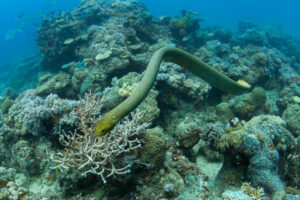Udyawer, V., Goiran, C., Chateau, O., Coutures, E., Vigliola, L., & Shine, R. (2023). Long-distance movements of free-ranging sea snakes (Hydrophis, Elapidae). Coral Reefs. https://doi.org/10.1007/s00338-023-02408-1
Sea snakes are members of the Elapidae family, a group of venomous snakes characterized by protruding fangs from the top of the mouth. They spend most or all of their lives in the ocean and are found all over the Indo-Pacific. Most of what we know about them has been learned by studying individuals in fishing bycatch, which is the accidental capture of nontarget marine animals. One of the mysteries surrounding sea snakes is their movement patterns. Knowing where and how far animals travel allows researchers to gain insights into their behavior, migratory routes, and preferred habitats. This can help assess the species’ role within the ecosystem and their vulnerability to localized stressors.
Homebodies or long-distance travelers?

Researchers used a method called acoustic telemetry to record the movement patterns of 33 individual sea snakes across four species: the Greater Sea Snake (Hydrophis major), the Slender-necked Sea Snake (H. coggeri), the Olive Sea Snake (Aipysurus laevis), and the Reef Shallows Sea Snake (A. duboisii). Acoustic transmitters were surgically implanted in snakes captured in shallow bays near Noumea in New Caledonia. To record their movement patterns, 18 underwater listening stations were deployed throughout the study area. The acoustic transmitter emits unique acoustic signals that are picked up by the underwater listening stations when a snake passes by. The listening stations record the time, date, and unique identification of each signal so the researchers can study individual movement patterns.
While a majority of the individuals across species were recorded within 2 km of their release site, a number of individuals traveled farther than expected. The maximum distances traveled for A. duboisii, H. coggeri, and H. major were 3.4 km, 12.6 km, and 15.3 km, respectively. Remarkably, this is the first direct evidence of long-distance travel by sea snakes ever recorded! Since terrestrial snakes are known to have shorter movement patterns, researchers suspect sea snakes may be using ocean currents and tidal flow to travel such far distances.

Oh, the places they’ll go!
As predators of fish and cephalopods (like squid and octopus), sea snakes play an important role in maintaining the ecological balance within their ecosystems. Understanding where and how far sea snakes move can help inform and manage human activities that impact their habitats and survival. On one hand, the capacity for long-distance traveling means sea snakes are less susceptible to localized environmental threats such as habitat destruction and pollution. On the other hand, though, traveling long distances means a greater potential for harmful fishing and/or boating interactions. Since this is the first time acoustic telemetry has been used to track the movement patterns of sea snakes, more research is needed to fully understand their capacity for dispersal and the foremost threats these unique creatures face.
Cover photo by Claire Goiran, CC BY 3.0.

I’m an MSc student in marine biology at the University of Hawaiʻi at Mānoa. I conduct research through the Johansen Fish Resilience Lab at the Hawaiʻi Institute of Marine Biology. I’m currently studying the effects of sedimentation on the foraging behavior of herbivorous coral reef fish. Before grad school, I got a double BS in environmental geology and environmental studies at Tufts University before working at a shark research lab in the Bahamas. In my free time, you can find me climbing, running, or reading at the beach.

